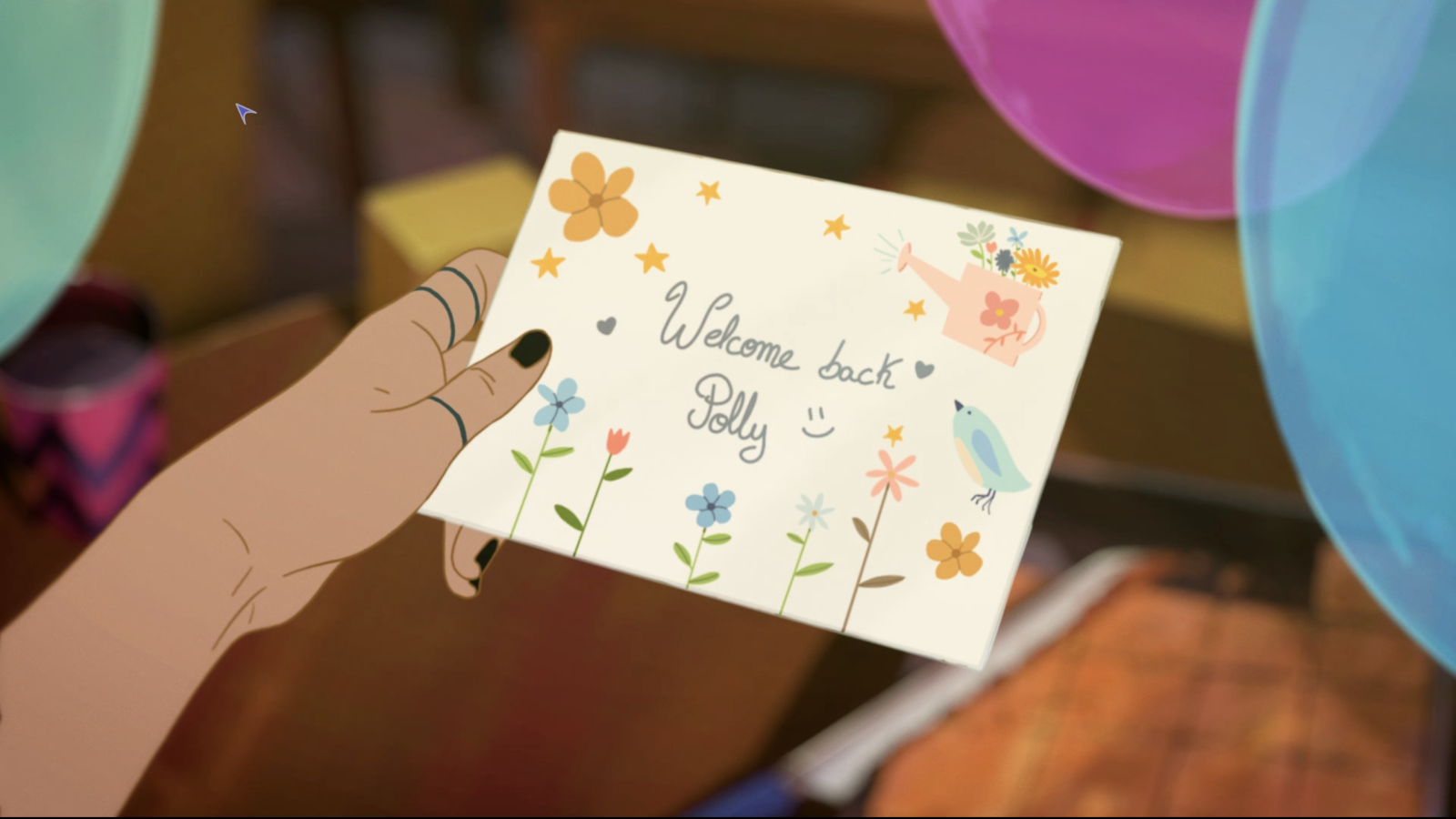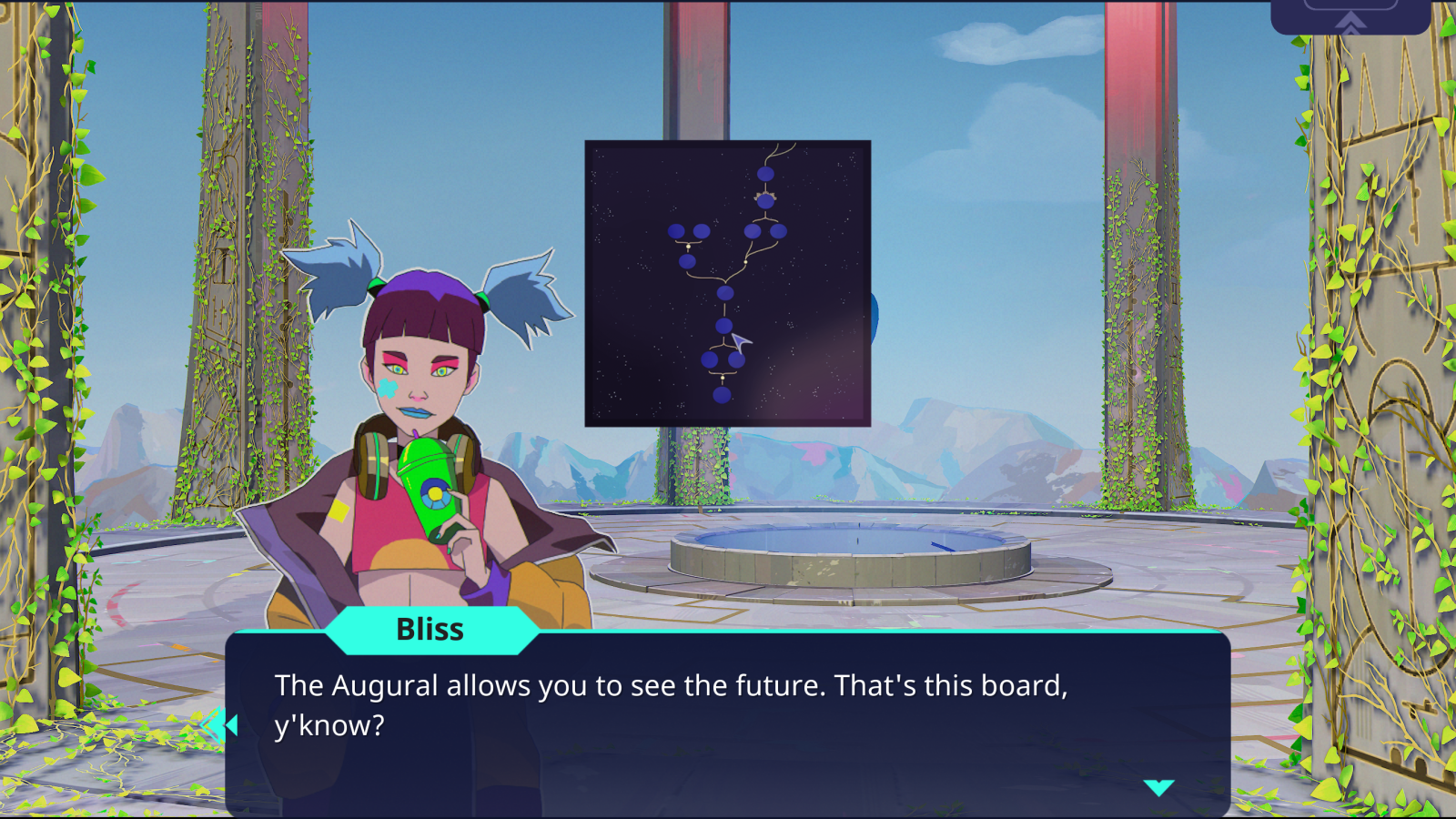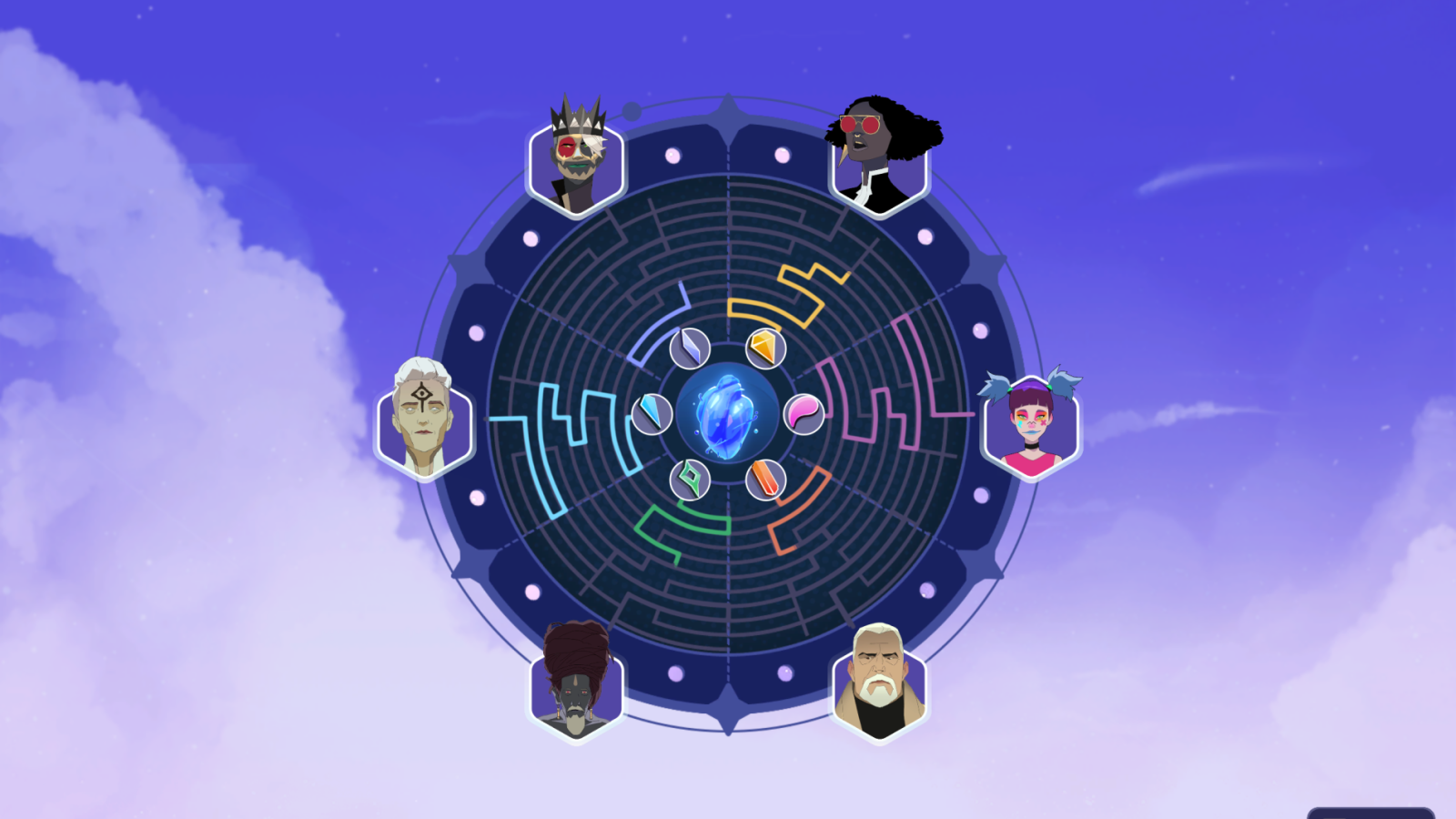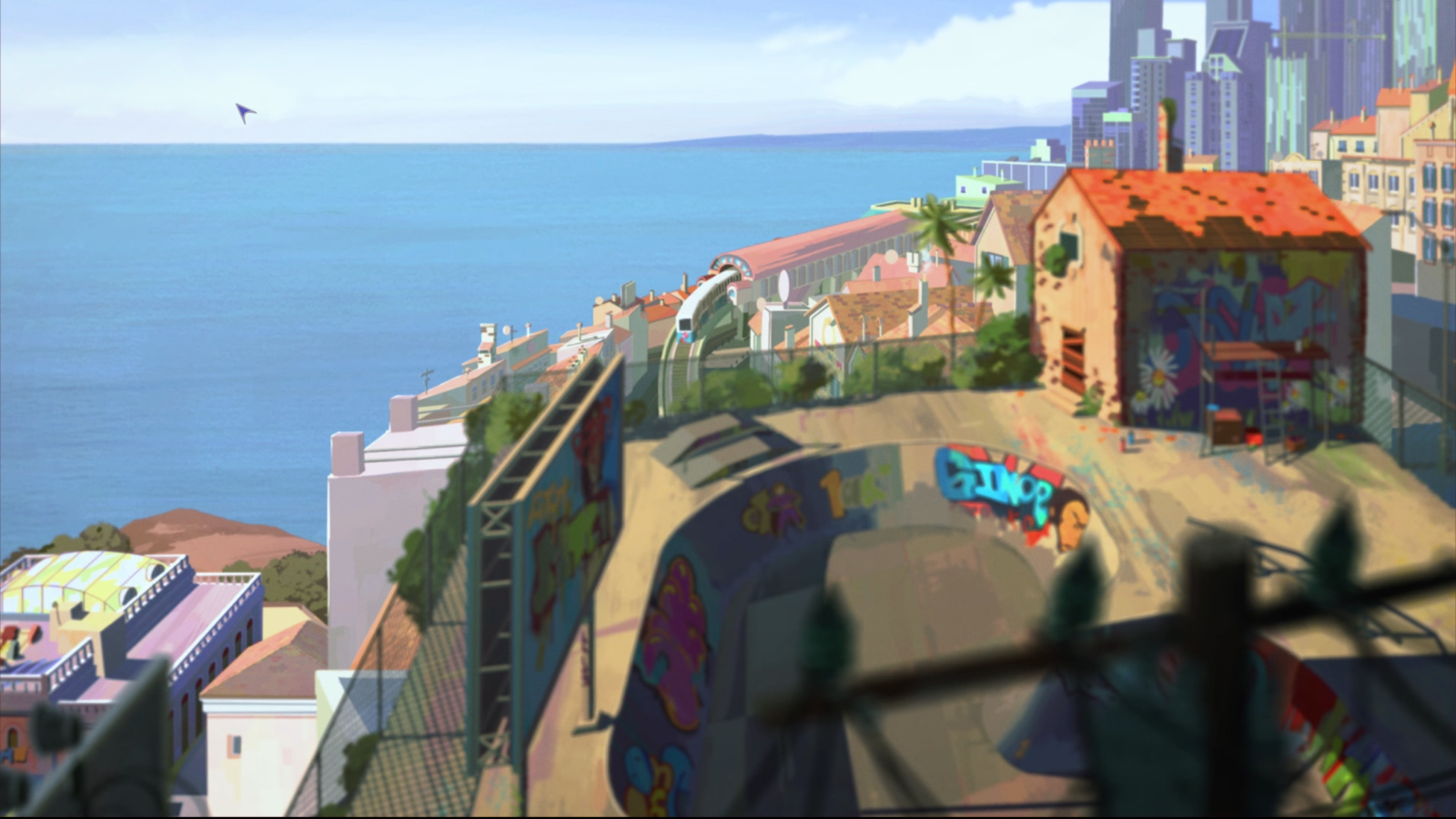Harmony: The Fall of Reverie follows Polly’s return home to search for her missing mother in her hometown, Atina. As she arrives, Polly is transported to the Reverie, an intangible realm populated by Aspirations, beings that embody humankind’s hopes, dreams, and boundless intelligence. As the story unfolds, Polly will travel between Brittle – the material world – and Reverie – the intangible plane. Polly is given the role by an Oracle named Harmony, a messenger between Brittle and Reverie. She is tasked with maintaining the balance between both worlds. She gains the ability to see into the future. She is guided by Aspirations in her endeavors to find her mother, reestablish the balance between Brittle and Reverie, and rebuild the community of Atina. Atina is devastated and in a state of decay and disarray while resisting the Mono Konzern (MK) conglomerate for unity and freedom.

Back home
Harmony: The Fall of Reverie is a visual novel and an anticipated release from Don’t Nod, creators of Life is Strange. Their immersive storytelling blends the ordinary and the extraordinary, crafting captivating tales that deliver emotional experiences.

Welcome back
The game is a visual narrative where characters, narrative, artwork, and gameplay set it apart from the numerous games in the genre. This game is an entirely new beast. In our game preview, we got a glimpse of this captivating story and were left craving for more. Now we revisit the game in its entirety, and it delivers on our expectations. Every choice has meaning. Every twist and turn is engaging and breathtaking.

Transported to Riverie
Harmony: The Fall of Reverie was released on June 8.
Gameplay – balancing constraints and choices to achieve desired outcomes

Bliss and the Augural
We invite you to our preview article “Harmony: The Fall of Reverie preview – A Tale of Hope and Belonging” for a more in-depth description of gameplay.
During most of the game, you will be a spectator as a graceful story is unveiled. You will discover a beautiful tale (or multiple) full of twists, turns, and unexpected surprises. Each character is introduced and developed to create a bond and resonate with the player; for better or worse.
Being a visual novel, it successfully provides a rich narrative for players to immerse themselves in. Different paths emerge as you approach the game’s end and every decision counts.
The game blends elements from adventure stories, game books, and narrative games. Indeed, you will spend most of your time watching the narrative developing, dialogues, and cutscenes. Ultimately, your choices determine the story’s outcome. You will be reminded of Don’t Nod’s story-driven games, their signature, and their sense of delight.
As we highlighted in our game preview, Harmony’s gameplay is based on the Augural, the core mechanism of the game. In the Augural, you “can see further than ever before.” The Augural presents a flow diagram of nodes, where each Node represents a decision you can take throughout the story. By using the Augural, players can plan, make decisions, and ultimately shape the narrative of Harmony: The Fall of Reverie.

The Augural
Nodes describe what they represent, their pre-conditions, and their consequences. Each choice comes with repercussions and may question your ethics and morality. Poly can gaze into the future portrayed in the game mechanics by allowing you to see future nodes. When you choose a node, you may lock or unlock others; some nodes can help you see further into the future. Nodes can be associated with the influence of Aspirations. Aspiration Power Crystals may be rewarded, requested, or consumed depending on the chosen Node. In the game, the Augural is the central mechanism that ties everything together. If you want to reach a specific future outcome, its constraints will drive your choices and force you to take a particular course of action.
Review – Immersive storytelling, a tale of wonder
It is difficult not to compare it to a game such as Phoenix Wright, a widely popular visual novel series, or to a narrative game such as the recently released The King’s Dilemma: Chronicles. If you are from my generation, you will feel transported on a nostalgic trip to the classic Choose Your Own Adventure and Fighting Fantasy books.
However, Harmony: The Fall of Reverie has a different vibe, agency, and unique mechanics. It blends elements from visual novels, adventure stories, game books, and narrative games with a novel and core mechanism: the ability to see into the future.

Bliss SanctuarySanctuaries
The Augural is the primary source of engagement and “frustration” during the game. It may be unclear initially, and planning your path to reach your desired decision point may be challenging. Looking into the future and choosing an outcome constraints agency and drives player decisions. In this process, you lose your “free will” and may follow a linear path to ensure you reach your intended point in the story. The progression mirrors how when life closes all doors, we lose agency and can only move in one direction. However, you will never get stuck in the game; there will always be paths to follow.
While you’ll spend most of your time watching the story unfold, the Augural makes this game stand out. It is unique in giving the player agency while getting a sneak peek of what lies ahead.
We noticed that the pace of the game changes to match the storyline. In some moments, there are multiple paths to choose and follow, as well as others with a single path to follow based on a result of previous decisions.

The Heart
While the game provides diverse views, such as the Heart Screen, the Codex, and the Augural, it is a visual novel at its core. It is approachable, intuitive, and self-introduces all of its many elements. It is not a difficult game per se, but you are not guaranteed that your choices will result in the conclusions you expect. Therein lies the beauty of this game: in its touch of surprise, sense of connection, and spark of joy.
With a vast number of decision points, Harmony: The Fall of Reverie takes players on a unique journey each time you play it. Our first thought when the game finished was to start it again. We’ve spent over a hundred hours playing Harmony and would not hesitate to spend another few hundred uncovering its secrets.

Gorgeous
Regarding graphics and audio, the game is breathtaking. Both visuals and soundtrack are interwoven to deliver an immersive experience. It is strongly recommended that you use a surround sound system or headphones.
One minor issue with the game is that although it is gorgeous, it uses and abuses the same graphical assets repeating them over and over again. These can include character illustrations and background scenes. During most of the game, you will be presented with one or two characters in the foreground, a background scene, and a dialog popup. The repeated use of assets can quickly become tedious and dampen the awe and excitement that capture players at the beginning of this magical journey. Players may lose immersion, ignore the game visuals and focus on the dialogue alone. It is a significant oversight for a game that shines through its stunning artwork and is our major issue with the game.
Harmony: The Fall of Reverie embraces inclusivity and diversity. It tackles challenging issues with beauty, genuineness, and integrity. The story promotes LGBTQ+ values gracefully and with beautiful characters; it deliberately uses the pronouns they/them instead of he/him or she/her. It tackles the issue of immigration, where workers are pushed over the limits, afraid of losing their “permit of stay.” It breaks down barriers and misunderstandings regarding mental health by compassionately addressing mental health-related topics such as depression, anxiety, grief, and the loss of living ones. When approaching the subject of grief, it reminds us that memory is a powerful force for change. The story is touching and conveys an emotional tone when deserved and without being forced.
We loved Harmony: The Fall of Reverie and were captivated by its narrative from beginning to end. With over a hundred hours of gameplay, the game keeps us returning for as long as this beautiful story takes us to new places of wonder. We want to know more about all the story paths we have missed.
While it is not utterly disruptive as a visual novel, it does introduce the Augural mechanism, which adds freshness to the genre. This core mechanism and the game’s stunning artwork make it stand out.

First and foremost, Harmony: The Fall of Reverie tells a captivating story. It excels in all aspects of game analysis, from its core mechanics to its fictional & narrative involvement, artwork, and replayability. Unfortunately, visual assets are re-used too often, breaking the first-sight sense of awe. Still, it stands out in the visual novel genre. Quoting the game, "change is a long-term process," and even the smallest decisions can have huge repercussions. You can spend tens of hours playing the game and keep returning for more. We can envision Harmony: The Fall of Reverie as a compelling narrative board game; all the ingredients and the core framework are already in place. We highly recommend the game for those looking for a captivating and emotionally interactive narrative. It is a must-play for visual novel & story-driven game fans.
PROS
- It offers a captivating and emotionally interactive narrative that keeps players engaged from beginning to end.
- Every decision in the game carries weight and consequences, giving players a strong sense of agency and making their choices feel significant.
- Most of the time, Harmony settles in a relaxing mood. Still, its twists and turns may make your decisions increasingly challenging.
CONS
- Repeated use of visual assets diminishes the immersive experience.
- Occasional linear progression restricts player agency.
- Long narrative passages enhance the game’s brilliance, but not all players may appreciate the lack of action.
Mindful Phil is an Engineer and Entrepreneur with a very creative side, fulfilled by many “amateur” hobbies such as Board Games, Video Games, Writing, Photography, Music Composition, DJing, Miniature Painting, etc. Mindful Phil has been a gamer since his early childhood. His first venture into video games was with the game Pong, long before the Atari came out. Then, he played everything from Atari to Nintendo, Arcades, Sega games, Playstation, PC games, and even the Xbox (yeah, I know!). He currently loves his Nintendo Switch and has both a PS4 and a PS5 for serious gaming and multiplayer with his wife and friends. He is also a fan of retro games and enjoys being a "Raspberry Pi modder”; Mindful Phil is an avid fan of board games and miniature games. He was introduced into the world of board games around twenty years ago with CATAN, and that quickly became an obsession. He plays board games as pure escapism from his demanding job responsibilities. Articles provided by Roll & Mind (www.rollandmind.com).
See below for our list of partners and affiliates:

 10 months ago
78
10 months ago
78








